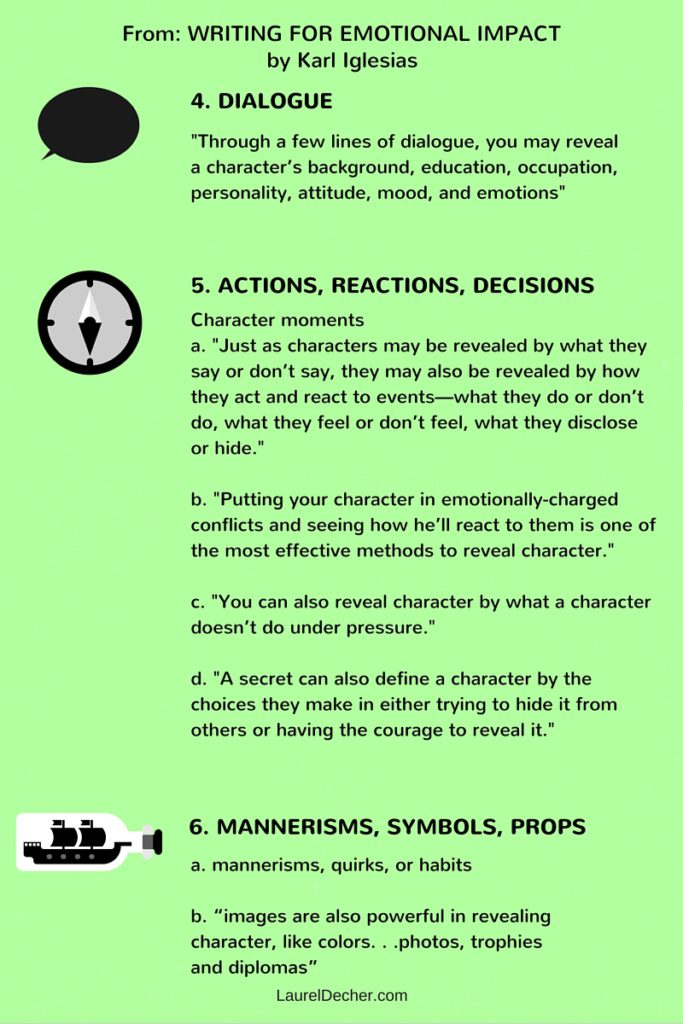
Click here to download Six Ways to Reveal Character handout as a pdf with links to Karl Iglesias’ website and to WRITING FOR EMOTIONAL IMPACT.
I’ve been studying Karl Iglesias’ insightful and practical WRITING FOR EMOTIONAL IMPACT while reading Nancy J. Cavanaugh‘s funny, charming, and warm THIS JOURNAL BELONGS TO RATCHET for Middle Grade readers.
When I went back over my notes, I realized that THIS JOURNAL BELONGS TO RATCHET uses all six of Karl Iglesias’ ways to reveal character on the page. The strong characterization kept me reading, even though the story has a potentially challenging structure: Ratchet’s handwritten language arts assignments. The story is so well constructed, I stopped noticing the writing assignments.
Note: the handwriting font worked perfectly on my Kobo e-reader and was very easy to read.
- NAME AND DESCRIPTION. The main character goes by the nickname of Ratchet. Cavanaugh ties the unusual name to the universal emotion of a father’s love for his daughter. Ratchet got her nickname because of “the way [her] help makes all [her father’s] jobs easier.” She describes her father “like a young Albert Einstein wearing a greasy T-shirt and ripped jeans.”
- CONTRAST. Ratchet’s internal conflicts come out in her writing assignments: “And wish/ I didn’t wish for so much/ Because I know Dad/ Tries real hard.” She and her environmental activist father are a classic “odd couple.” She’s longing for shiny new school supplies and clothes and feels like a “fish out of water” in the rec center’s GET CHARMED class.
- OTHER CHARACTERS. The boys yell insults based on the current gossip about her father whenever they walk by Ratchet’s house. Her father’s activism affects Ratchet directly. Other characters are affected by Ratchet’s behavior and her willingness to share her mechanical knowledge.
- DIALOGUE. Because the book is in journal-format, the whole story is told in Ratchet’s voice. She quotes her father and his attitudes, background, and worldview shine through: “Those idiots would spend their time rearranging deck chairs on the Titanic. They don’t even have the sense to use the brains the Good Lord gave them.'”
- ACTIONS, REACTIONS, DECISIONS. Much to Ratchet’s embarrassment, her father wears T-shirts with slogans like: “Is it me or is this place a festival of idiots?” to the city council meetings. As the story progresses, the slogans change. Both Ratchet and her father keep secrets from each other, but I won’t spoil the story by saying what they are. There’s a great incident where Ratchet helps someone the reader really doesn’t think she will help. Both Ratchet and her father are put under pressure in ways that really make their true character visible.
- MANNERISMS, SYMBOLS, PROPS. The story is told in Ratchet’s “Homeschool Language Arts Journal” so the book itself is her prop. Then there are the mechanic’s tools and engines that play such an important role in making the story go. And a very important box.
These 6 Ways to Reveal Character are from one tiny section of Karl Inglesias’ WRITING FOR EMOTIONAL IMPACT. It’s worth reading the whole book, even if you’re a chicken like me and have to skip the SILENCE OF THE LAMBS’ examples. There are also a few FINDING NEMO examples. Maybe someday he’ll write a new edition including Middle Grade books.
You can probably tell how much I enjoyed reading THIS JOURNAL BELONGS TO RATCHET and how inspired I am by Nancy Cavanaugh‘s craftsmanship. Have you read it? What did you think? I’d love to know.
